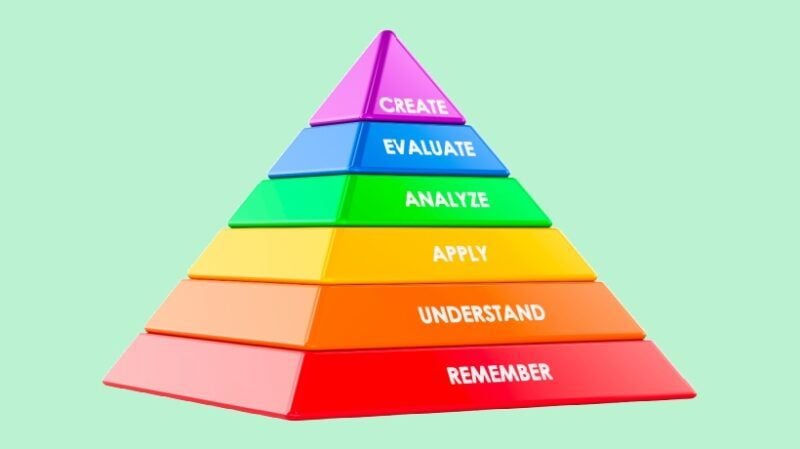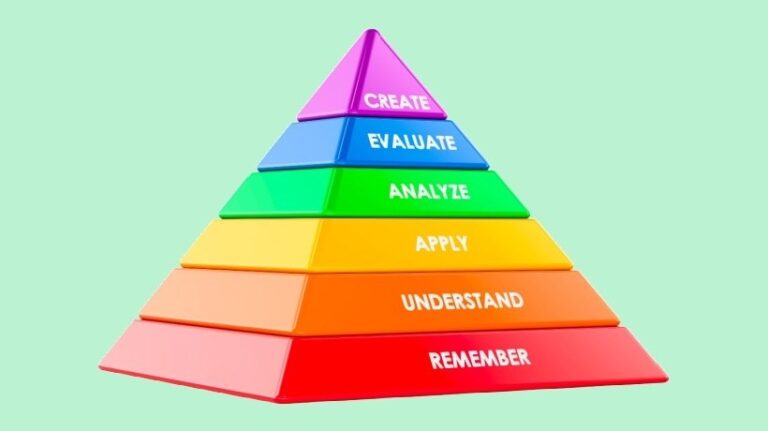
Old frameworks, new associations
Does your learning goal start with “understanding”, “apply”, or “analysis”? If so, you probably used Bloom’s taxonomy, intentional or not.
This six-stage framework has been guided by instructional designers for decades. But in 2025 it’s time to ask, with AI-enhanced learning, personalized pathways and immersive technology reshaping the way we learn. Do I still need to use it? Or did you quietly slip into the archives of educational design history?
The answer isn’t just “yes.” That’s “Yes, if you know how to make it work for today.”
This article revisits Bloom’s well-known learning framework, assesses its role in digital learning environments, and provides suggestions on how modern education designers can apply or adapt to today’s e-learning situation.
What is the Bloom taxonomy?
In 1956, educational psychologist Benjamin Bloom, along with a team of researchers, introduced a framework called “Bloom’s Classification of Educational Goals.”
This model aims to help teachers and educators design better learning experiences by categorizing levels of thinking and learning.
The original taxonomy focused on cognitive domains, the ways in which people acquire and use knowledge, and was organized into a hierarchy of six categories, ranging from the simplest to the most complex mental skills.
Knowledge – Reminisces facts, terms, and basic concepts. Understanding – Understanding meaning, translation, or interpretation. Application – Use study materials in new situations. Analysis – Decompose the material to understand its structure. Synthesis – Together parts to form a new whole. Rating – Determine the value of ideas and materials.
This version has been widely used for decades to create lesson plans, assessments and learning outcomes, especially in classrooms and traditional educational settings.
Revised Bloom Taxonomy: Anderson & Krathwohl (2001)
In 2001, former Bloom student Lorin Anderson and cognitive psychologist David Classwall guided the team, revised and modernised the original taxonomy to reflect a greater understanding of learning and teaching.
Remember apply apply analyze evaluation create
Important changes to the revised version include:
1. Verb-based categories
The original nouns (such as “knowledge” or “synthesis”) have been changed to verbs to reflect the positive nature of learning. for example:
I remembered that knowledge became an understanding of understanding and integration was created.
2. Sort hierarchy
In the revised version, Create was placed at the highest level above. This is because creating a new one is considered more complicated than evaluating existing ideas.
3. 2D
The revised taxonomy introduces a two-dimensional framework.
Dimensions of Knowledge – Fact, conceptual, procedural, and metacognitive knowledge. Dimensions of Cognitive Processes – Six Thinking Levels: Memorization, Understanding, Applying, Analyzing, Assessing, and Creating.
This allowed educators to categorize not only what students should know, but how they should think about that knowledge.
Why the revised version is important today
The revised taxonomy is more consistent with the modern learning environment, especially in e-learning and corporate training. that:
Use action words that make your writing learning goals easier and more effective. Encourages higher-order thinking in project-based, experiential and online learning. It supports educational design models such as Addie, Sam, and Backward Design.
Using the revised version, education designers can more accurately coordinate activities, content, and assessments for what learners need to achieve, especially in digital and remote learning contexts.
Rethinking the Bloom Classification for Today’s Learners
Bloom’s taxonomy continues to be relevant, but today’s learners have different expectations. They want learning to be interactive, fast, mobile-friendly and real-world focused.
So how do we adapt Bloom’s taxonomy to modern e-learning?
1. Pairing Bloom’s classifications with real-life contexts
Instead of abstract tasks, we link each level to something that the learner may do at work. For example, instead of simply “analyzing the data,” it encourages learners to “analyse customer feedback and improve their services.”
2. Use multimedia and simulation
Bloom levels can be achieved through interactive video, branching scenarios, AR/VR, and simulation. These tools allow learners to apply, analyze and create in a safe and engaging environment.
3. Integrate with Agile and Rapid Development Models
Traditional teaching designs have been linear. But now, agile models like Sam and Design Thinking are driving rapid iteration. Bloom’s can still be adapted by treating it as a flexible guide rather than a strict rulebook.
Create smart learning goals using action verbs in Bloom
Learning goals Set the foundation for your course. They guide what content to include, how learners interact with it, and how success is measured.
How to do it:
Use smart criteria (identifiable, measurable, achievable, relevance, time of day) when writing your goals. Select the exact action verb from Bloom’s taxonomy based on the cognitive level you want to target. Example: Remember → “List the computer parts.” Analysis → “Distinguish between qualitative and quantitative data.” Create → “Design a marketing plan for a new product.”
This will help both designers and learners to clarify and significantly track learners’ progress.
Match content and ratings to the same level of thinking
A common mistake in teaching design is to teach at one level and evaluate at another, which is misorganization.
How to do it:
If your goal is at the application level (“Calculate ROI using formula”), ask that the lesson activities and quizzes be applied to learners, not just formulas. Avoid testing memory if your goal is analysis or evaluation. Ensure that all quizzes, scenarios, or assignments directly support the desired bloom level.
This alignment increases the effectiveness and reliability of learning, particularly in corporate or compliance training.
Especially for the microlearning module, start small
Microlearning is intended to be concentrated and easy to consume. Trying to teach too much in a short module will overwhelm the learner and weaken the retention.
How to do it:
Focus on one Bloom level per microlearning module, especially the lower level you remember. Example: Create another short lesson (apply) showing how learners “define phishing attacks” (remember) (recognize phishing emails).
This allows the modules to be scalable and stackable, ultimately supporting more complex learning paths.
Use higher-order thinking for capstone activities or final evaluation
Capstone activities or end-of-course assessments are where learners demonstrate true mastery.
How to do it:
Challenging learners to use what they have learned to analyze, evaluate, or create something. Example: Analyse real case studies and provide recommendations. Evaluate a variety of software tools and select the best software tool for your task. Create a presentation or suggestion that solves the problem.
These higher-order tasks can help bridge the gap between theory and real-world performance, especially in vocational training and skill development.
Mixing modalities: Using text, videos, interactive tools, and real tasks
People learn in a variety of ways, and digital learning environments offer endless possibilities for multimodal teaching.
How to do it:
Use text and infographics to remember and understand levels. Include a video or demo to apply. Add branching scenarios, simulations, or roleplays for analysis and evaluation. Projects, storytelling, or real-world tasks for creation.
Mixing media not only maintains engagement, but also targets different cognitive levels of Bloom’s taxonomy to ensure a richer learning experience.
Conclusion
Bloom’s taxonomy may have been developed in another era, but its value in educational design remains timeless. At its heart, it is not just a hierarchy of verbs. A roadmap for meaningful learning.
Bloom’s taxonomy provides the structure needed to be purposefully designed, with content to be engaging, adaptable and results-driven. It balances creativity and clarity and ensures that every module, quiz or activity moves learners towards real understanding and performance.
The key is to use it as a flexible thinking tool rather than as a strict formula. This evolves with learners’ technology, trends and changing needs.
BrainCert LMS
BrainCert lets you create, sell and sell courses, tests, and live classes. Over 300 features support training, assessment, compliance, proposed exams and more. Includes virtual classrooms, badges and reports.


